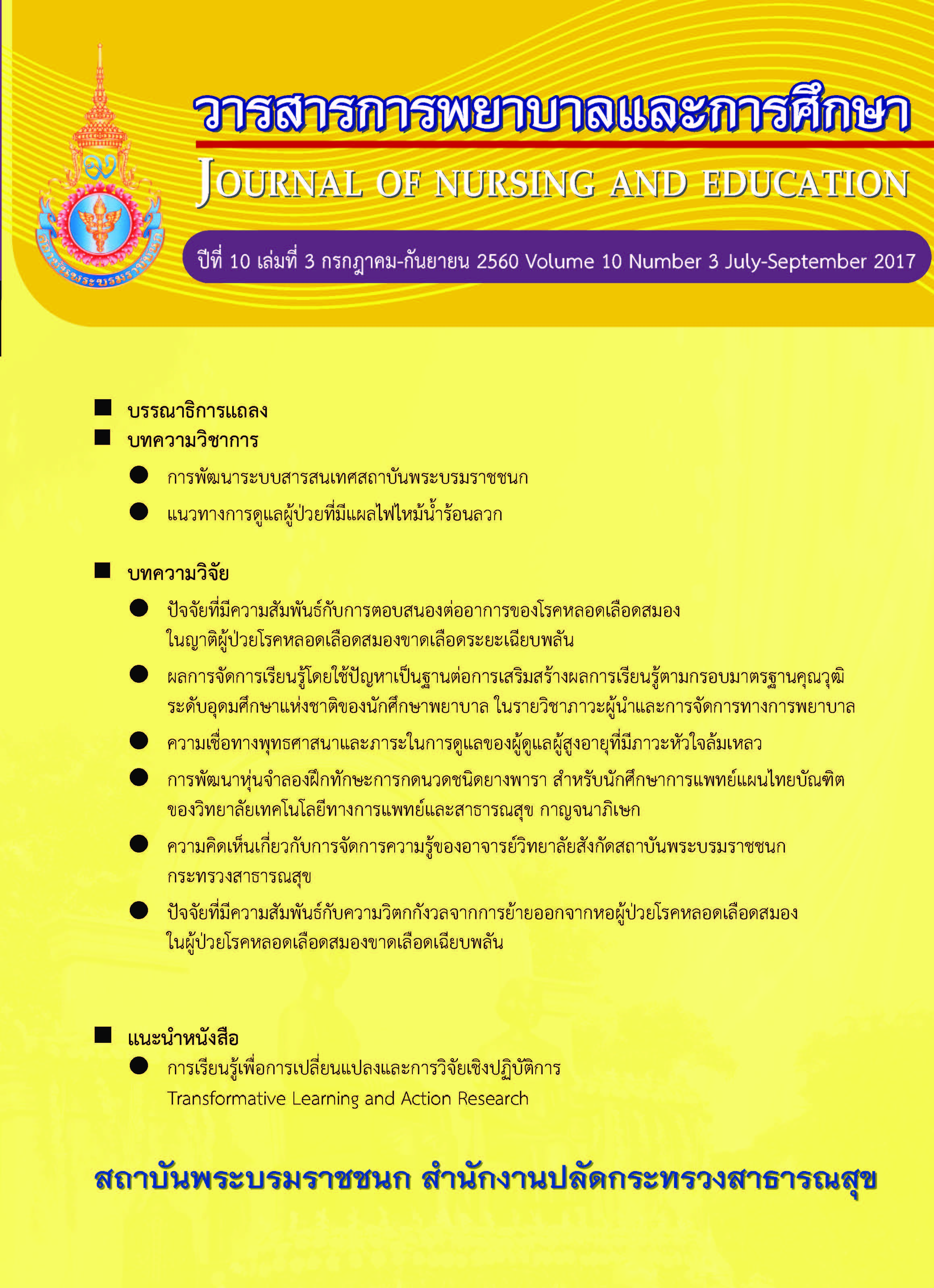ปัจจัยที่มีความสัมพันธ์กับการตอบสนองต่ออาการของโรคหลอดเลือดสมอง ในญาติผู้ป่วยโรคหลอดเลือดสมองขาดเลือดระยะเฉียบพลัน
คำสำคัญ:
การได้รับข้อมูลข่าวสารเกี่ยวกับโรคหลอดเลือดสมอง, ความรู้เกี่ยวกับโรคหลอดเลือดสมอง, การรับรู้ความเสี่ยงต่อการเกิดโรคหลอดเลือดสมอง, การตอบสนองต่ออาการ ของโรคหลอดเลือดสมอง, Source of Information of Stroke, Knowledge about Stroke, Perceived Risk of Stroke, Family Members of Patients with Acute Ischemic Stroke.บทคัดย่อ
บทคัดย่อ
การวิจัยครั้งนี้ มีวัตถุประสงค์เพื่อศึกษาความสัมพันธ์ระหว่างประสบการณ์การได้รับข้อมูลข่าวสารเกี่ยวกับโรคหลอดเลือดสมอง การรับรู้ความเสี่ยงต่อการเกิดโรคหลอดเลือดสมอง ความรู้เกี่ยวกับโรคหลอดเลือดสมองกับการตอบสนองต่ออาการของโรคหลอดเลือดสมอง ในญาติผู้ป่วยโรคหลอดเลือดสมองขาดเลือดระยะเฉียบพลัน กลุ่มตัวอย่าง คือ ญาติผู้ป่วยที่นำผู้ป่วยโรคหลอดเลือดสมองขาดเลือดระยะเฉียบพลันรายใหม่มารับการรักษาในหน่วยงานอุบัติเหตุฉุกเฉิน โรงพยาบาลชลบุรี จำนวน 90 ราย สุ่มตัวอย่างโดยวิธีการกำหนดช่วงเวลาเก็บรวบรวมข้อมูลและคัดเลือกกลุ่มตัวอย่างตามคุณสมบัติที่กำหนด เครื่องมือที่ใช้ในการวิจัย ประกอบด้วย แบบสอบถามข้อมูลส่วนบุคคล แบบสอบถามประสบการณ์การได้รับข้อมูลข่าวสารเกี่ยวกับโรคหลอดเลือดสมอง แบบสอบถามความรู้เกี่ยวกับโรคหลอดเลือดสมอง แบบสอบถามการรับรู้ความเสี่ยงต่อการเกิดโรคหลอดเลือดสมองและแบบสอบถามการตอบสนองต่ออาการโรคหลอดเลือดสมอง เก็บรวบรวมข้อมูลในช่วงเดือนพฤศจิกายน 2559
ถึงเดือนกุมภาพันธ์ 2560 วิเคราะห์ข้อมูลด้วยสถิติพรรณนา และสถิติสัมประสิทธิ์สหสัมพันธ์ของเพียร์สัน ผลการวิจัยพบว่า ระยะเวลาตั้งแต่ผู้ป่วยเกิดอาการจนกระทั่งมาถึงโรงพยาบาล ใช้เวลาเฉลี่ย 7.41 ชั่วโมง โดยมีผู้ป่วยร้อยละ 42.2 มาถึงโรงพยาบาลภายในเวลา 4.5 ชั่วโมง กลุ่มตัวอย่างมีประสบการณ์การได้รับข้อมูลข่าวสารเกี่ยวกับโรคหลอดเลือดสมองในระดับมาก ( Mean =2.16, SD=0.94) มีการรับรู้ความเสี่ยง
การเกิดโรคหลอดเลือดสมองในระดับมาก ( Mean =2.52, SD=2.79) มีความรู้เกี่ยวกับโรคหลอดเลือดสมองในระดับปานกลาง ( Mean =10.11, SD=2.31) และมีการตอบสนองต่ออาการของโรคหลอดเลือดสมองในระดับปานกลาง ( Mean =52.19, SD=6.79) ผลการวิเคราะห์ความสัมพันธ์พบว่า ประสบการณ์การได้รับข้อมูลข่าวสารเกี่ยวกับโรคหลอดเลือดสมอง การรับรู้ความเสี่ยงต่อการเกิดโรคหลอดเลือดสมอง ความรู้เกี่ยวกับ
โรคหลอดเลือดสมอง มีความสัมพันธ์ทางบวกกับการตอบสนองต่ออาการของโรคหลอดเลือดสมอง อย่างมีนัยสำคัญทางสถิติ (r=.22*, r=.36**, r=.22* ตามลำดับ)ผลการศึกษาครัง้ นีเ้ สนอแนะวา่ ควรใหค้ วามรเู้ กีย่ วกบั ปจั จยั เสี่ยง อาการเตือน การรักษาทีมี่ประสิทธิภาพ
และการจัดการเมื่อเกิดอาการของโรคหลอดเลือดสมอง เพื่อให้ญาติผู้ป่วยเกิดการตอบสนองต่ออาการของโรคหลอดเลือดสมองอย่างถูกต้องและเหมาะสม
เอกสารอ้างอิง
2. Bureau of Non Communicable Disease.Information and Statistic Number and Mortality Rate of Stroke Patients per hundred thousand people in 2007-2014 Classified by province, region and country (included Bangkok) [Online]. 2016 [cited 2016 March 18].Available from: thaincd.com/informationstatistic/non-communicable-diseasedata.php (in Thai).
3. Fassbender,K., et al. Streamlining of prehospital stroke management the golden hour. Neurology. 2013; 12:585-596.
4. Emberson, J., et al Effect of treatment delay, age, and stroke severity on the effects of intravenous thrombolysis with alteplase for acute ischaemic stroke: a meta-analysis of individual patient data from randomized trials.Lancet. 2014; 384: 1929-35.
5. Schumm, AR., et al Translation of the ‘time is brain’ concept into clinical practice: focus on prehospital stroke management. International Journal of Stroke. 2014; 9: 333-340.
6. Droste, DW., et al. Stroke Awareness in Luxemburg: Deficit Concerning Symptoms and Risk Factors. Clinical Medicine Insights: Cardiology. 2014;8(s2): 9-13.
7. Hartigan, I., et al. The Irish national stroke awareness campaign: a stroke of success?. Nursing Research. 2014;27: 13-19.
8. Memis, S., et al. Multiple Causes for Delay in Arrival at Hospital in Acute Stroke Patients in Aydin, Turkey. Biomed
Central Neurology. 2008; 8(15): 17-21.
9. Lekpet, J., Wuthisuthimethawee, P.,Vasinanukorn, P. Prehospital time and Emergency Department time for acute ischemic stroke care at Songklanagarind Hospital. Songkla Med J, 2009; 27(3):203-212.
10. Potisopha, W., Utriyaprasit, K., Sindhu,S. Relationships among response to symptoms and hospital arrival time
of acute stroke patients. J Nurse Sci Health. 2015; 38(1): 9-20. (in Thai)
11. Zhao, Q., et al. Instrument Development and Validation of the Stroke Pre-hospital Delay Behavior Intention Scale in a Chinese Urban Population.Health and Quality of Life Outcomes.2014; 12: 170-178.
12. Leventhal, H., Brissette, I., Levanthal,EA. The common-sense model of self-regulation of health and illness.In: D. L. Cameron, & H. Leventhal.(Eds.). The self- regulation of health and illness behavior. London: Routledge;2003. 42-65.
13. Marx, JJ., et al. An educational multimedia campaign improves stroke knowledge and risk perception in different stroke
risk groups. European Journal of Neurology. 2009; 16(5): 612-618.
14. Tijayoung, S. The Factors Influencing Preventive Behaviors Amongst Risk Group Stroke Patients. [Thesis] Christian
University: Bangkok; 2014. (in Thai)
15. Jirawatkul, A. Statistics for health science research. Nonthaburi: Office of the Permanent Secretary, Ministry of Public Health; 2007. (in Thai)
16. Saeko, U., Jitpanya, C. A Study of Stroke Awareness in Stroke Risks Patients.Princess of Naradhiwas University Journal. 2014; 6(2): (in Thai)
17. Pandian, JD., et al. Public Awareness of Warning Symptoms, Risk Factors,and Treatment of Stroke in Northwest India. AHA Journal. 2005; 36(3): 644-648.
18. Kumtip, P., Jitpanya, C. Relationships among Knowledge, Belief, and Behavioral Awareness in Young Adult at High Risk
of Stroke. Journal of The Police Nurse.2014; 6(2): (in Thai)
19. Kittboonthawal, P., Yingrengreung, S.,Srithanya, S. Perceptions of Stroke Warning Signs among Risk Patients. Nursing Journal of the Ministry of Public Health, 2013; 23(3), 132-141.(in Thai)
20. Hodgson, C., Lindsay, P., Rubini, F. Can Mass Media Influence Emergency Department Visits for Stroke. Stroke.2007; 38: 2115-2122.
21. Nualnetr, N., Srikha, D. Knowledge on the stroke and behaviors to reduce the risk of stroke among risk persons in Samliam Community, Muang District,Khonkaen Province. J Med Tech Phy Ther. 2012; 24(3): 318-326. (in Thai)
22. Binthaisong, T., et al. Factors Related to Onset Arrival Time in Patients with Acute Stroke. Kuakarun Journal of Nursing, 2013; 20(1): 15-29. (in Thai)
23. Kamsareeruk, J., Jitpanya, C. Factors Related to Prehospital Time in Patients with Acute Ischemic Stroke. Journal of The Police Nurse. 2015; 7(2):(in Thai)
24. Siddiqui, M., et al. Factors Delaying Hospital Arrival of Patients with Acute Stroke. Journal of Pakistan Medicine.
2008; 58(4).
25. Chang, KC., Tseng, MC., Tan, TY.Prehospital Delay after Acute Stroke in Kaohsiung, Taiwan. Stroke. 2004; 35:700-704.
26. Nakibuuka, J., et al. Knowledge and Perception of Stroke: A Population-Based Survey in Uganda. ISRN Stroke.
2014; 24: 210-218.
27. Mosley, I., et al. What is stroke symptom knowledge?. International journal of stroke. 2014; 9: 48-5






